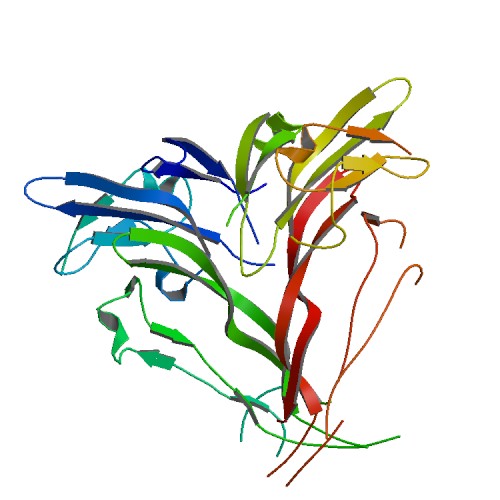ACVR2B
Template:Protbox Activin A receptor, type IIB, also known as ACVR2B, is a human gene.[1] ACVR2B is an activin type 2 receptor. Activins are dimeric growth and differentiation factors which belong to the transforming growth factor-beta (TGF-beta) superfamily of structurally related signaling proteins. Activins signal through a heteromeric complex of receptor serine kinases which include at least two type I (I and IB) and two type II (II and IIB) receptors. These receptors are all transmembrane proteins, composed of a ligand-binding extracellular domain with cysteine-rich region, a transmembrane domain, and a cytoplasmic domain with predicted serine/threonine specificity. Type I receptors are essential for signaling; and type II receptors are required for binding ligands and for expression of type I receptors. Type I and II receptors form a stable complex after ligand binding, resulting in phosphorylation of type I receptors by type II receptors. Type II receptors are considered to be constitutively active kinases. This gene encodes activin A type IIB receptor, which displays a 3- to 4-fold higher affinity for the ligand than activin A type II receptor.[1]
References
Further reading
- Burdine RD, Schier AF (2000). "Conserved and divergent mechanisms in left-right axis formation". Genes Dev. 14 (7): 763–76. PMID 10766733.
- Hildén K, Tuuri T, Erämaa M, Ritvos O (1994). "Expression of type II activin receptor genes during differentiation of human K562 cells and cDNA cloning of the human type IIB activin receptor". Blood. 83 (8): 2163–70. PMID 8161782.
- De Winter JP, De Vries CJ, Van Achterberg TA; et al. (1996). "Truncated activin type II receptors inhibit bioactivity by the formation of heteromeric complexes with activin type I. receptors". Exp. Cell Res. 224 (2): 323–34. PMID 8612709.
- Attisano L, Wrana JL, Montalvo E, Massagué J (1996). "Activation of signalling by the activin receptor complex". Mol. Cell. Biol. 16 (3): 1066–73. PMID 8622651.
- Nishitoh H, Ichijo H, Kimura M; et al. (1996). "Identification of type I and type II serine/threonine kinase receptors for growth/differentiation factor-5". J. Biol. Chem. 271 (35): 21345–52. PMID 8702914.
- Martens JW, de Winter JP, Timmerman MA; et al. (1997). "Inhibin interferes with activin signaling at the level of the activin receptor complex in Chinese hamster ovary cells". Endocrinology. 138 (7): 2928–36. PMID 9202237.
- Ishikawa S, Kai M, Murata Y; et al. (1998). "Genomic organization and mapping of the human activin receptor type IIB (hActR-IIB) gene". J. Hum. Genet. 43 (2): 132–4. PMID 9621519.
- Macías-Silva M, Hoodless PA, Tang SJ; et al. (1998). "Specific activation of Smad1 signaling pathways by the BMP7 type I receptor, ALK2". J. Biol. Chem. 273 (40): 25628–36. PMID 9748228.
- Kosaki R, Gebbia M, Kosaki K; et al. (1999). "Left-right axis malformations associated with mutations in ACVR2B, the gene for human activin receptor type IIB". Am. J. Med. Genet. 82 (1): 70–6. PMID 9916847.
- Lee S, Alexander J, Blowes R; et al. (2000). "Determination of resonance frequency of the respiratory system in respiratory distress syndrome". Arch. Dis. Child. Fetal Neonatal Ed. 80 (3): F198–202. PMID 10212081.
- McPherron AC, Lawler AM, Lee SJ (1999). "Regulation of anterior/posterior patterning of the axial skeleton by growth/differentiation factor 11". Nat. Genet. 22 (3): 260–4. doi:10.1038/10320. PMID 10391213.
- Bondestam J, Horelli-Kuitunen N, Hildén K; et al. (2000). "Assignment of ACVR2 and ACVR2B the human activin receptor type II and IIB genes to chromosome bands 2q22.2-->q23.3 and 3p22 and the human follistatin gene (FST) to chromosome 5q11.2 by FISH". Cytogenet. Cell Genet. 87 (3–4): 219–20. PMID 10702675.
- Chapman SC, Woodruff TK (2001). "Modulation of activin signal transduction by inhibin B and inhibin-binding protein (INhBP)". Mol. Endocrinol. 15 (4): 668–79. PMID 11266516.
- Wurthner JU, Frank DB, Felici A; et al. (2001). "Transforming growth factor-beta receptor-associated protein 1 is a Smad4 chaperone". J. Biol. Chem. 276 (22): 19495–502. doi:10.1074/jbc.M006473200. PMID 11278302.
- Parks WT, Frank DB, Huff C; et al. (2001). "Sorting nexin 6, a novel SNX, interacts with the transforming growth factor-beta family of receptor serine-threonine kinases". J. Biol. Chem. 276 (22): 19332–9. doi:10.1074/jbc.M100606200. PMID 11279102.
- Choi KC, Kang SK, Nathwani PS; et al. (2001). "Differential expression of activin/inhibin subunit and activin receptor mRNAs in normal and neoplastic ovarian surface epithelium (OSE)". Mol. Cell. Endocrinol. 174 (1–2): 99–110. PMID 11306176.
- Lee SJ, McPherron AC (2001). "Regulation of myostatin activity and muscle growth". Proc. Natl. Acad. Sci. U.S.A. 98 (16): 9306–11. doi:10.1073/pnas.151270098. PMID 11459935.
- Matsuzaki T, Hanai S, Kishi H; et al. (2002). "Regulation of endocytosis of activin type II receptors by a novel PDZ protein through Ral/Ral-binding protein 1-dependent pathway". J. Biol. Chem. 277 (21): 19008–18. doi:10.1074/jbc.M112472200. PMID 11882656.
- Schneider-Kolsky ME, Manuelpillai U, Waldron K; et al. (2002). "The distribution of activin and activin receptors in gestational tissues across human pregnancy and during labour". Placenta. 23 (4): 294–302. doi:10.1053/plac.2002.0787. PMID 11969340.
| Stub icon | This genetics article is a stub. You can help Wikipedia by expanding it. |

